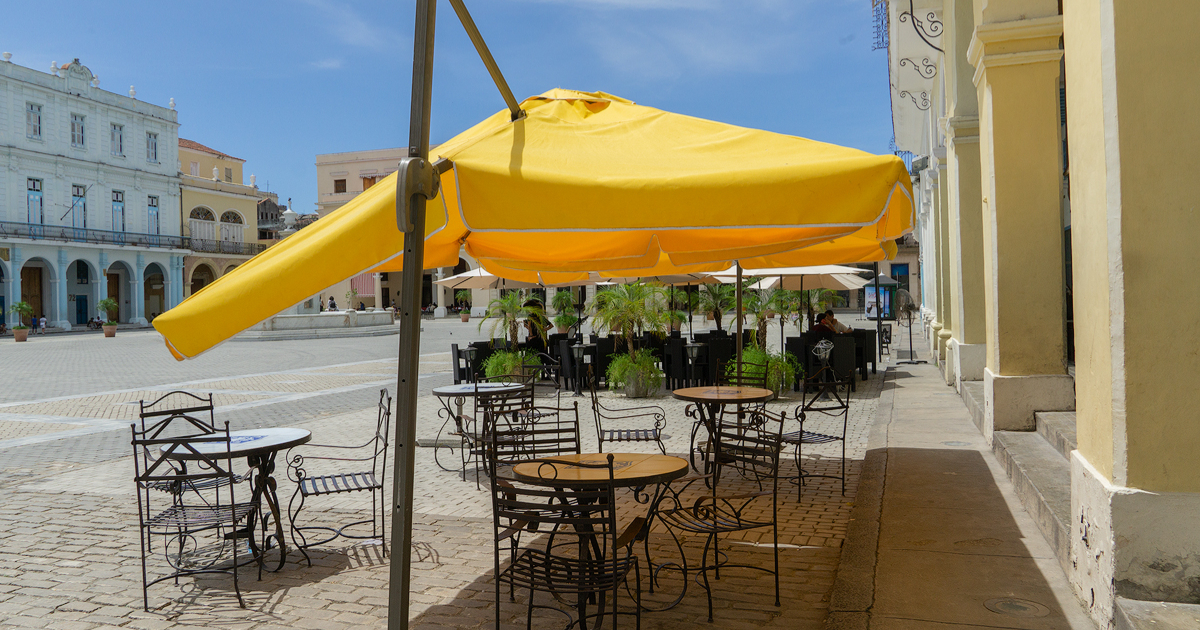The historic core of Old Havana, once bustling with foreign tourists lounging in parks or cafes, enjoying live music in restaurants, or simply strolling, now presents a picture of somber isolation. Streets and squares that used to be crowded with large groups of international visitors are completely deserted, as observed by CiberCuba last Saturday morning, a time when these iconic spots in the city are usually teeming with people.
Photos and testimonies attest to the severe impact of the international tourism crisis on the Cuban capital. A woman who makes a living braiding hair on Obispo and Mercaderes streets told our newsroom that in recent days, there have been almost no visitors, with the situation being worse during weekdays. "I think I'll have to sell my chair to pay the taxes," she confessed.
Everyone agrees that tourists are almost non-existent, despite the government's attempts to portray the sector as recovering. This week, Cuban economist Pedro Monreal exposed false data on tourist arrivals in Cuba during the first half of this year.
The regime, through Cubadebate, reported that 1.8 million visitors arrived on the island from January to June. However, according to Monreal, this is not feasible because "to accumulate 1.8 million visitors in January-June, 625,112 visitors would have had to arrive in June, but the highest number of visitors received in a June in recent years was in June 2018 (342,195)."
The Cuban Tourism Minister congratulated himself on April 26 for reaching one million visitors in the first quarter and announced that the target for this year is three million. This is an impossible goal to achieve, despite being lower than the target set for 2023. That year, Cuba failed to reach the projected 3.5 million foreign tourists, falling short at 1.9 million (up to October), lagging significantly behind its regional neighbors like the Dominican Republic, which received six million, and Cancun, which hosted four million.
Moreover, the crisis has been felt more acutely in Havana, as several airlines have cut their flights, maintaining service only to tourist destinations such as Varadero and the Keys. One cause of this decline is the poor quality of hotel services in the country, leading to numerous complaints and even lawsuits in international courts.
In May, a Russian blogger recounted her 16-day stay at the five-star Varadero Iberostar Laguna Azul hotel, after which she decided never to return to Cuba due to "the locals' indifference and lack of effort to improve services." She criticized, "In a five-star hotel, there was no kettle in the room, and in the restaurant, instead of boiling water, they brought lukewarm water. Apparently, to prevent tourists from accidentally burning themselves because there are no burn remedies in pharmacies," she quipped.
"Unlike normal countries, where you first receive service and then express your gratitude, in Cuba, you first have to pay some dollars and then hope for a clean towel in your room. Or it might not appear at all," she added.
The government has been forced to acknowledge the tourism sector's problems, including insufficient air connectivity, unpaid suppliers disrupting the supply chain, difficulties accessing the international market, and a lack of staff to work in the facilities.
Impact of Tourism Crisis on Old Havana
This section addresses frequently asked questions about the current tourism crisis in Old Havana, its causes, and potential solutions.
Why are there no tourists in Old Havana?
The absence of tourists in Old Havana is primarily due to the international tourism crisis affecting Cuba. Poor hotel services, reduced flights, and the government's misleading data on tourist arrivals have contributed to this decline.
What measures is the Cuban government taking to address the tourism crisis?
The Cuban government has acknowledged issues such as insufficient air connectivity, unpaid suppliers disrupting the supply chain, and a lack of staff. However, concrete measures to resolve these problems remain unclear.
How reliable are the Cuban government's tourism statistics?
Economist Pedro Monreal has exposed discrepancies in the government's reported tourist arrival figures. The data suggests a much higher number of visitors than what is realistically possible, casting doubt on the reliability of these statistics.
